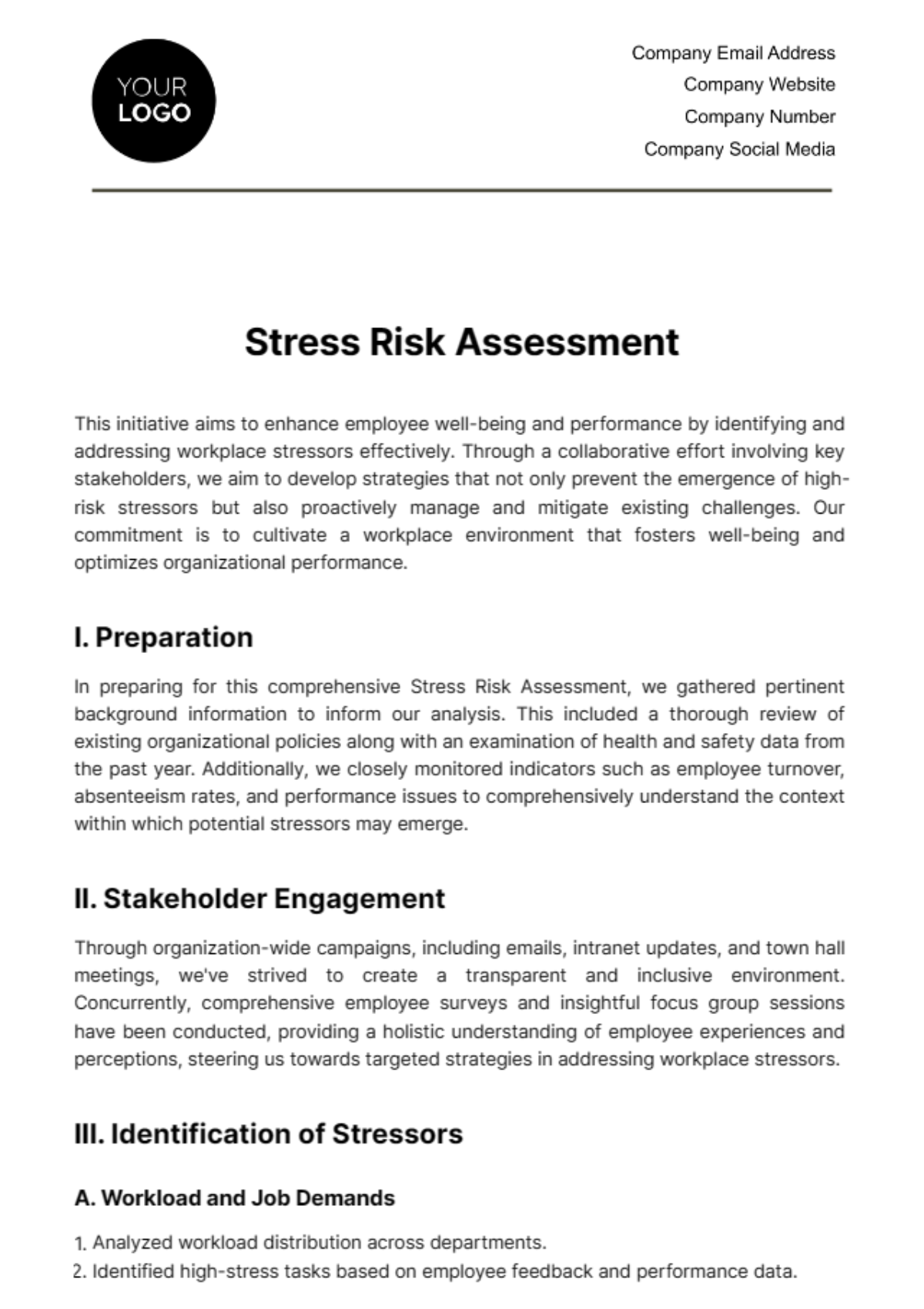Free Stress Risk Assessment

This initiative aims to enhance employee well-being and performance by identifying and addressing workplace stressors effectively. Through a collaborative effort involving key stakeholders, we aim to develop strategies that not only prevent the emergence of high-risk stressors but also proactively manage and mitigate existing challenges. Our commitment is to cultivate a workplace environment that fosters well-being and optimizes organizational performance.
I. Preparation
In preparing for this comprehensive Stress Risk Assessment, we gathered pertinent background information to inform our analysis. This included a thorough review of existing organizational policies along with an examination of health and safety data from the past year. Additionally, we closely monitored indicators such as employee turnover, absenteeism rates, and performance issues to comprehensively understand the context within which potential stressors may emerge.
II. Stakeholder Engagement
Through organization-wide campaigns, including emails, intranet updates, and town hall meetings, we've strived to create a transparent and inclusive environment. Concurrently, comprehensive employee surveys and insightful focus group sessions have been conducted, providing a holistic understanding of employee experiences and perceptions, steering us towards targeted strategies in addressing workplace stressors.
III. Identification of Stressors
A. Workload and Job Demands
Analyzed workload distribution across departments.
Identified high-stress tasks based on employee feedback and performance data.
B. Organizational Culture and Leadership
Evaluated leadership styles through surveys and interviews.
Assessed the alignment of organizational values with employee well-being.
C. Relationships
Analyzed team dynamics through focus groups and surveys.
Identified and addressed conflicts affecting relationships within and between teams.
D. Role Ambiguity and Job Control
Assessed clarity of job roles through interviews and surveys.
Evaluated the level of autonomy and control employees have in their roles.
IV. Risk Analysis
In assessing the likelihood and impact of identified stressors, we ranked each factor, enabling us to prioritize interventions effectively. The focus is on addressing high-priority stressors, ensuring a targeted and strategic approach to risk mitigation, safeguarding both employee well-being and organizational resilience.
V. Control Measures
Our preventive measures encompass tailored training programs and flexible work arrangements, proactively minimizing stressors. Simultaneously, our mitigating measures introduce a confidential Employee Assistance Program (EAP) and regular check-ins, providing robust support structures to address ongoing challenges and promote a healthier work environment.
VI. Implementation Plan
A meticulously crafted timeline outlines the phased implementation of our intervention strategies over the next six months. This plan includes specific milestones and deadlines, ensuring a systematic and timely execution of control measures, while a comprehensive responsibility matrix clarifies accountability for each aspect of the implementation.
VII. Monitoring and Evaluation
Our Key Performance Indicators (KPIs) focus on reducing absenteeism rates and enhancing employee satisfaction. Regular feedback mechanisms, including surveys and quarterly reviews, will provide valuable insights. This ongoing monitoring ensures the adaptability and effectiveness of our interventions, fostering a culture of continuous improvement in response to dynamic organizational needs.
VIII. Documentation and Reporting
Our documentation captures all facets of the assessment process, serving as a reference for future initiatives. The detailed report for organizational leaders communicates key findings, actions taken, and recommendations, fostering transparency and accountability in our commitment to employee well-being.
IX. Continuous Improvement
Establishing a robust feedback loop, our continuous improvement process is designed to evolve based on employee feedback and organizational dynamics. This adaptive strategy ensures that our initiatives remain aligned with the ever-changing needs of our workforce, fostering a resilient and supportive workplace culture.
This Stress Risk Assessment underscores our dedication to a workplace culture that prioritizes employee well-being. By embracing flexibility, adapting strategies, and fostering open communication, we aspire to create an environment where our employees thrive both personally and professionally.
Prepared By:
[Your Name]
[Job Title]
[Month Day, Year]
- 100% Customizable, free editor
- Access 1 Million+ Templates, photo’s & graphics
- Download or share as a template
- Click and replace photos, graphics, text, backgrounds
- Resize, crop, AI write & more
- Access advanced editor
Introducing Template.net's Stress Risk Assessment Template, a vital tool for evaluating workplace stress factors. Fully customizable and editable with our Ai Editor Tool, this template empowers businesses to tailor stress assessments to their specific needs. Streamline stress management protocols and mitigate risks effortlessly with our user-friendly platform. Simplify stress assessments and enhance employee well-being with this comprehensive template solution.





























